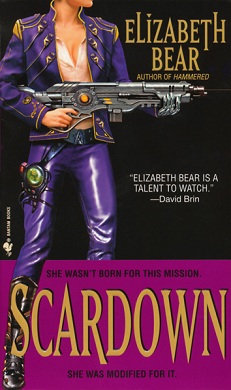
Scardown
Elizabeth Bear
368 pages
published in 2005
Scardown is Elizabeth Bear’s second novel, sequel to Hammered, continuing the adventures of Jenny Casey. Where Hammered was straight up streetlevel cyberpunk, in Scardown the perspective opens up. That opening up actually started in the last pages of Hammered and Scardown continues seamlessly. Middle books in a trilogy, as this is can often sag, neither setting up plotlines nor resolving them, but Scardown avoids this fate. Each of the books in the Hammered/Scardown/Worldwired has its own story, but together they do add up to one coherent one.
Jenny Casey is a veteran who lost her left arm and eye in a war in South Africa decades ago, replaced by fairly primitive cyborg implants. Her ability to cope and survive for so long with these implants made her an unique candidate for starship pilot training, as these pilots would need to be plugged into their spaceships. This is why she was being pursued by the Canadian government in the previous novel, Canada and China being the world’s two superpowers in 2062. The world is dying, killed by climate change and humanity’s hope lies in the stars. Which is why both superpowers are building starships, starships made possible by alien technology found on Mars.
Hammered ended with Jenny Casey and her lover Gabe Castaign setting foot on board the Montreal, Canada’s first functional starship. Scardown begins with Jenny making preparations for her first trip as a pilot with the ship. She has made her peace with colonel Valens — the villain of the previous book — for the moment, even if she’s not reconcilled with what he did to her decades earlier. It’s just that she knows they all have bigger problems now. On a more optimistic note, at least she, Gabe and Elspeth Dunsany have come to an understanding regarding their relationships, starting to form a proper family together with Gabe’s two daughters, Leah and Genie.
Valens meanwhile is shown to be more than just a cardboard villain, or even the dedicated patriot trying to do the best for his country, no matter the cost that he was in Hammered. This is done not just because we get to see more of what motivates him, but also because of the introduction of his granddaughter Patty, who with Leah Castaign is one of the young volunteers for the starship programme. It’s just one example of how Bear opens up the story in this volume, following not just the characters from the first book — Jenny, Elspeth, Gabe, the Richard Feynman AI, Razorface et all– but also giving more screentime to secondary characters like Valens, as well as introducting new characters: Min-xue, a Chinese starship pilot, a young Canadian terrorist called Indigo Xu who has business with Jenny, the Canadian prime minister Constance Riel, various others.
This wider range of viewpoints compared to Hammered reinforces the opening up of the story. This is no longer about Jenny Casey and while it remains her story, what’s at stake is no longer the fate of one woman, but that of whole nations. Both the Chinese and the Canadian governments are convinced Earth’s climate is damaged to the point of unsustainability and the only solution is to get as many people off planet and to the stars as possible. Yet neither is willing to see the other side getting their first, with the Chinese in particular aggressive in sabotaging the Canadian process.
To be honest, the geopolitics (literally) is perhaps the most unconvincing aspect of the story. It was already established in the previous novel that the US had become a fundamentalist state for a while and therefore drifted out of superpower status, but to see Canada, at the head of the Commonwealth — the UK having frozen over when the Gulfstream shut down — as the dominant superpower together with China is a bit difficult to believe. India and Pakistan apparantly had a brief nuclear war sometime before 2062, while the European Union, Russia, Africa and South America are only mentioned in passing. It doesn’t quite convince me as a possible future, it feels more like a bog standard dystopian sf future with some of the furniture moved.
But that’s a minor quibble. Some of the background may bit a bit sketchy, the story Bear tells with it is worth it. There’s a steady ratching up of tension as the various plotlines come together, culminating in a climax about fourfifths through the book that’s literally world changing, the last fifth of the story dealing with the fallout of it.
What really impressed me about Scardown though — which in a better world wouldn’t be a reason to be impressed by a sf novel — is the wide variety of well rounded female characters in it. This is a book that passes the Bechdel test with flying colours. It’s not just Jenny Casey who’s important, all the named female characters are driving the plot as much as their male counterparts, if not more. Similarly, like Casey, most of the important characters are pushing middle age, with everything that entails. They carry the aches and pains and experiences of four-five decades of living. That too is somewhat unusual in science fiction.